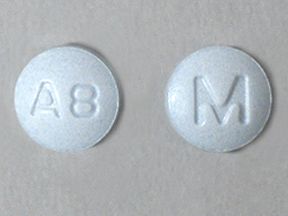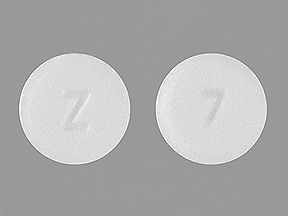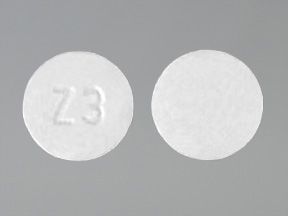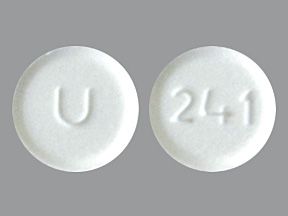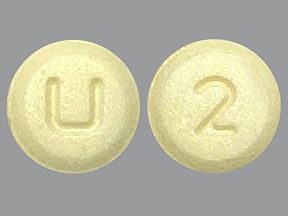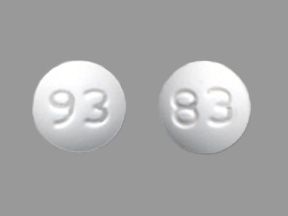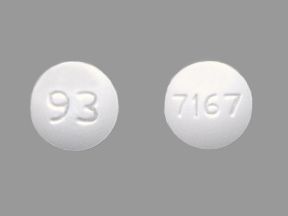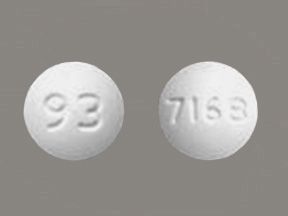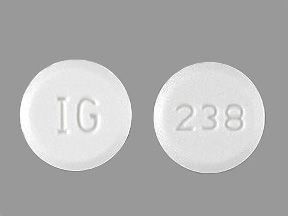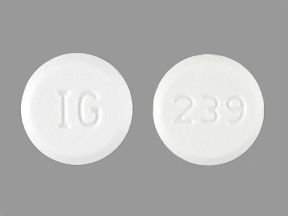Amlodipine oral tablet contains the active drug amlodipine besylate. It’s classified as a calcium channel blocker.
If you have certain heart conditions, your doctor may prescribe amlodipine oral tablet for you.
It’s a prescription drug that’s used to treat high blood pressure in adults and some children. It’s also used to treat coronary artery disease (CAD) in adults. (CAD prevents your arteries from supplying enough blood to your heart. And this can lead to angina, which is a type of chest pain.)
For high blood pressure and CAD, you may take amlodipine oral tablets with other drugs.
To learn more about these conditions and how amlodipine is used to treat them, see the “What is amlodipine oral tablet used for?” section below.
Amlodipine oral tablet basics
Amlodipine oral tablet contains the active drug amlodipine besylate. This drug is classified as a calcium channel blocker.
You’ll take amlodipine oral tablets by swallowing them.
Note: Amlodipine also comes as an oral suspension (a type of liquid mixture). But only the oral tablet is described in this article. If you’d like to learn about amlodipine’s other form, talk with your doctor or pharmacist.
Amlodipine oral tablet brand-name versions
Amlodipine oral tablet is a generic medication. But it is also available in a brand-name version called Norvasc.
Note: The oral suspension form of amlodipine has another brand-name drug version. To learn about this other version, talk with your doctor or pharmacist.
Amlodipine oral tablet is a generic drug. A generic drug is an exact copy of the active drug in a brand-name medication. Norvasc is the brand-name medication that amlodipine oral tablet is based on. A generic is considered to be as safe and effective as the original drug. Generics tend to cost less than brand-name drugs.
If you’re interested in using Norvasc instead of amlodipine oral tablet, talk with your doctor. They can tell you if Norvasc comes in strengths that can be used for your condition. If you have insurance, you’ll also need to check whether your plan will cover Norvasc.
To learn more about how generics compare with brand-name drugs, see this article.
Like most drugs, amlodipine oral tablet may cause mild or serious side effects. The lists below describe some of the more common side effects. These lists don’t include all possible side effects.
Keep in mind that side effects of a drug can depend on:
- your age
- the dosage you’re prescribed
- other health conditions you have
- other medications you may be taking
Your doctor or pharmacist can tell you more about the potential side effects of amlodipine oral tablet. They can also suggest ways to help reduce side effects.
Mild side effects
Here’s a short list of some of the mild side effects that amlodipine oral tablet can cause. To learn about other mild side effects, talk with your doctor or pharmacist, or read amlodipine oral tablet’s prescribing information.
Mild side effects of amlodipine oral tablet that have been reported include:
- anxiety
- belly pain
- dizziness
- erectile dysfunction (ED)
- extreme drowsiness or sleepiness
- fatigue (lack of energy)
- flushing (temporary warmth, redness, or deepening of skin color)
- heart palpitations (irregular or fast heartbeat)
- joint pain
- lowered heart rate
- muscle problems, such as stiffness or tremor
- nausea
- peripheral neuropathy (nerve damage that causes symptoms such as leg pain)
- weight gain*
- edema (swelling)*
- constipation*
Mild side effects of many drugs may go away within a few days or a couple of weeks. But if they become bothersome, talk with your doctor or pharmacist.
* For more information on this side effect, see the “Side effect focus” section below.
Serious side effects
Serious side effects from amlodipine oral tablet can occur, but they aren’t common. If you have serious side effects, call your doctor right away. However, if you think you’re having a medical emergency, you should call 911 or your local emergency number.
Serious side effects of amlodipine oral tablet that have been reported include:
- angina (a type of chest pain) that’s worse than usual
- heart attack
- low blood pressure
- allergic reaction*
* For more information on this side effect, see the “Side effect focus” section below.
Side effect focus
Learn more about some of the side effects amlodipine oral tablet may cause.
Weight gain
You may have weight gain while you’re taking amlodipine oral tablets. But this wasn’t a common side effect in studies of the drug.
You may also gain weight if you have edema (swelling), which is a possible side effect of amlodipine oral tablet. For more information about this, see the “Edema, such as leg swelling” section just below.
What might help
If you’re concerned about weight gain while taking amlodipine, talk with your doctor. They can recommend healthy ways to manage your weight.
Edema, such as leg swelling
You may have edema (swelling) while you’re taking amlodipine oral tablets. This was the most common side effect reported in studies of the drug.
Swelling from amlodipine oral tablets typically happens in your arms, feet, hands, or legs. Your risk for swelling with amlodipine may increase with higher doses of the drug.
What might help
Tell your doctor about any swelling you have while you’re taking amlodipine oral tablets. They may lower the dosage you’re prescribed. Or they may switch you to a different drug to treat your condition.
If your swelling is mild and isn’t bothersome, your doctor may tell you it’s safe to keep taking amlodipine oral tablets. To help lessen swelling while taking this drug, you can try the following remedies:
If your swelling is severe or bothersome, your doctor may have you stop taking amlodipine oral tablets. If so, your swelling will likely go down within several days after stopping the drug.
Constipation
You may have constipation while you’re taking amlodipine oral tablets. But this wasn’t a common side effect in studies of the drug.
Constipation can cause symptoms such as:
- having fewer bowel movements than usual
- passing hard stools
- taking a longer time than usual to pass stools
What might help
Tell your doctor if you have constipation while taking amlodipine oral tablets.
If you have constipation, it’s important to keep your body hydrated by drinking plenty of water. You can also try eating certain foods to help stay hydrated.
Eating foods rich in fiber can help relieve your constipation. These foods include whole grains, vegetables, and raw fruits.
Over-the-counter medications, such as laxatives and stool softeners, are also effective for relieving constipation. But make sure you check with your doctor or pharmacist before taking any new medications with amlodipine oral tablet.
Allergic reactionSome people may have an allergic reaction to amlodipine oral tablet.
Symptoms of a mild allergic reaction can include:
- skin rash
- itchiness
- flushing (temporary warmth, redness, or deepening of skin color)
A more severe allergic reaction is rare but possible. Symptoms of a severe allergic reaction can include swelling under your skin, typically in your eyelids, lips, hands, or feet. They can also include swelling of your tongue, mouth, or throat, which can cause trouble breathing.
Call your doctor right away if you have an allergic reaction to amlodipine oral tablet. But if you think you’re having a medical emergency, call 911 or your local emergency number.
Your doctor will recommend the dosage of amlodipine oral tablet that’s right for you. Below are commonly used dosages, but always take the dosage your doctor prescribes.
Form and strengths
Amlodipine oral tablets are swallowed. They’re available in three strengths:
- 2.5 milligrams (mg)
- 5 mg
- 10 mg
Note: Amlodipine also comes as an oral suspension (a type of liquid mixture). But only the oral tablet is described in this article. If you’d like to learn about amlodipine’s other form, talk with your doctor or pharmacist.
Recommended dosages
The usual dose range from amlodipine varies, depending on the reason your doctor prescribes the drug for you. Your dose will also be based on:
- your age, as the recommended dosage may be lower for older people
- other health conditions you may have
Dosage for high blood pressure
To manage high blood pressure in adults, your doctor may prescribe a starting dosage of 5 mg of amlodipine once per day.
In certain cases, including if you’re taking other drugs for blood pressure, your doctor may prescribe a starting dosage of 2.5 mg once per day.
Your doctor will adjust your dose as needed, based on your blood pressure. The maximum dosage is 10 mg per day.
Dosage for coronary artery disease
For coronary artery disease (CAD), including angina (a type of chest pain), the recommended dosage range is 5 mg to 10 mg of amlodipine once per day. The maximum dosage is 10 mg per day.
Children’s dosage
Amlodipine oral tablet is used to treat high blood pressure in children ages 6 years and older. The recommended dosage range is 2.5 mg to 5 mg of amlodipine once per day in children.
Your child’s dose will be adjusted as needed based on their blood pressure.
Questions about amlodipine oral tablet dosing
Below are some common questions about amlodipine oral tablet’s dosing.
- What if I miss a dose of amlodipine oral tablet? You can take your missed dose of amlodipine as soon as you remember. But if more than 12 hours have passed since you missed the dose, skip it and take your next dose at the normal time. Talk with your doctor or pharmacist if you aren’t sure whether to skip or take a missed dose of amlodipine oral tablet.
- Will I need to use amlodipine oral tablet long term? Yes, most likely. You’ll probably take amlodipine long term if it’s working for you and isn’t causing bothersome side effects. Your doctor will tell you the right length of time to take amlodipine oral tablets.
- How long does amlodipine oral tablet take to work? Amlodipine oral tablets start working right away to treat your condition. But it may take a couple of days after your first dose for the drug to start lowering your blood pressure or easing your chest pain.
Your doctor will explain how you should take amlodipine oral tablets. They will also explain how much to take and how often. Be sure to follow your doctor’s instructions.
Taking amlodipine oral tablets
You’ll take amlodipine oral tablets by mouth, once per day. The drug isn’t typically taken twice a day.
You can take your dose any time of day. But the drug can cause side effects such as extreme drowsiness, sleepiness, and fatigue (lack of energy). So you may want to take your dose at bedtime.
Accessible medication containers and labels
If it’s hard for you to read the label on your prescription, tell your doctor or pharmacist. Certain pharmacies may provide medication labels that:
- have large print
- use braille
- contain a code you can scan with a smartphone to change the text into audio
Your doctor or pharmacist may be able to recommend a pharmacy that offers these options if your current pharmacy doesn’t.
Also, if you’re having trouble opening your medication bottles, let your pharmacist know. They may be able to put amlodipine oral tablets in an easy-open container. Your pharmacist may also recommend tools to help make it simpler to open the drug’s container.
Taking amlodipine oral tablets with other drugs
Amlodipine oral tablet may be used with other drugs that treat high blood pressure, coronary artery disease (CAD), and angina (a type of chest pain).
For high blood pressure, amlodipine may be used together with:
- angiotensin-converting enzyme inhibitors, such as:
- lisinopril (Zestril)
- benazepril (Lotensin)
- angiotensin II receptor blockers, such as:
- thiazide diuretics, such as hydrochlorothiazide (Microzide)
For CAD and angina, amlodipine oral tablet may be used together with:
- beta-blockers, such as:
- metoprolol (Lopressor)
- bisoprolol
- nitrates, such as:
- nitroglycerin (GoNitro)
- isosorbide mononitrate (Imdur)
If you have questions about other drugs that are right for treating your condition, talk with your doctor.
Questions about taking amlodipine oral tablets
Here’s a list of common questions about taking amlodipine.
- Can amlodipine oral tablets be chewed, crushed, or split? The manufacturer of amlodipine oral tablets hasn’t stated whether the drug can be chewed, crushed, or split. If you have trouble swallowing amlodipine tablets whole, talk with your doctor or pharmacist.
- Should I take amlodipine oral tablets with food? You can take amlodipine oral tablets with food or without it.
- Is there a best time of day to take amlodipine oral tablets? There isn’t a best time of day to take amlodipine oral tablets. They can be taken at any time of day (unless your doctor recommends taking your doses at a certain time). Taking your dose at about the same time each day can help you remember to take the medication. Doing this also helps keep a steady level of the drug in your body.
Questions for your doctorYou may have questions about amlodipine oral tablet and your treatment plan. It’s important to discuss all your concerns with your doctor.
Here are a few tips that might help guide your discussion:
- Before your appointment, write down questions like:
- How will amlodipine oral tablet affect my body, mood, or lifestyle?
- Bring someone with you to your appointment if doing so will help you feel more comfortable.
- If you don’t understand something related to your condition or treatment, ask your doctor to explain it to you.
Remember, your doctor and other healthcare professionals are available to help you. And they want you to get the best care possible. So don’t be afraid to ask questions or offer feedback on your treatment.
If you have certain heart conditions, your doctor may prescribe amlodipine oral tablet for you.
This drug is prescribed to treat high blood pressure. It’s used for this purpose in adults and children ages 6 years and older.
High blood pressure typically develops over the course of several years. You may not notice any symptoms from it. But it can make your heart work harder than normal to pump blood through your body.
But even without symptoms, high blood pressure can cause damage to your blood vessels and organs. It can especially affect your brain, heart, eyes, and kidneys.
Amlodipine oral tablet is also prescribed to treat coronary artery disease (CAD) in adults. CAD is a condition that causes your blood vessels to narrow, which lessens blood flow to your heart. This leads to angina (a type of chest pain).
Amlodipine oral tablet is used to treat these specific types of CAD:
- chronic (long-lasting) stable angina (a type of chest pain that happens in a predictable pattern)
- vasospastic angina (a type of chest pain that happens suddenly)
- CAD without heart failure
CAD causes impaired blood flow in the arteries that supply blood to your heart. This condition can increase your risk for heart attack if it’s not diagnosed and treated.
For both high blood pressure and CAD, you may take amlodipine oral tablets together with other drugs.
Amlodipine oral tablet is a type of drug called a calcium channel blocker. It works by widening your blood vessels. This helps lower your blood pressure and improves blood flow to your heart, which reduces chest pain.
Find answers to some commonly asked questions about amlodipine oral tablet.
What are some alternative drugs to amlodipine?
Amlodipine is prescribed to treat high blood pressure, coronary artery disease, and angina (a type of chest pain). It belongs to a group of drugs called calcium channel blockers.
Other medications are also used to treat these conditions. Below are a few alternatives to amlodipine:
- angiotensin-converting enzyme inhibitors, such as:
- lisinopril (Zestril)
- benazepril (Lotensin)
- angiotensin II receptor blockers, such as:
- beta-blockers, such as:
- metoprolol (Lopressor)
- bisoprolol
- statins, such as simvastatin (Zocor)
- calcium channel blockers, other than amlodipine, such as nifedipine (Procardia)
Each drug listed above works differently in your body to lower blood pressure or help supply blood to your heart. If you have questions about how amlodipine and its alternatives are alike and different, talk with your doctor.
Is amlodipine a beta-blocker, ACE inhibitor, or diuretic?
No, amlodipine isn’t a beta-blocker, angiotensin-converting enzyme (ACE) inhibitor, or diuretic.
Amlodipine belongs to a group of drugs called calcium channel blockers. Calcium channel blockers, beta-blockers, ACE inhibitors, and diuretics are used to treat similar conditions. But the drugs work in different ways in your body.
If you have questions about how amlodipine is different from these other types of drugs, talk with your doctor or pharmacist.
Will I have side effects when stopping amlodipine?
Yes, you may have certain side effects when stopping amlodipine. Your symptoms can depend on the reason you’re taking the drug.
For example:
- If you take amlodipine for high blood pressure, it’s likely your blood pressure will increase after you stop taking the drug.
- If you take amlodipine to treat coronary artery disease and angina (a type of chest pain), you may start having chest pain again after the drug is stopped.
Do not stop taking amlodipine unless your doctor says it’s safe to do so. If they recommend that you should stop amlodipine, it’s likely your doctor will decrease your dose slowly over time. This can help lessen any side effects that you may have from stopping the drug.
What’s amlodipine’s half-life? How long does it stay in your system?
The half-life of a drug is the time it takes for half of a dose of the drug to leave your body. Amlodipine’s half-life is 30 to 50 hours. In other words, it takes about 30 to 50 hours for your body to get rid of half of a dose of amlodipine.
It usually takes about five half-lives for a drug to leave your system entirely. For amlodipine, this means the drug will stay in your system for about 10 days after your last dose.
Does amlodipine cause hair loss?
No, it isn’t likely that you’ll have hair loss with amlodipine. Hair loss wasn’t seen in studies of the drug.
If you have hair loss while you’re taking amlodipine, talk with your doctor. They can check to see if something else is causing this condition.
Will I have a cough when using amlodipine?
No, you probably won’t have a cough when taking amlodipine. A cough wasn’t a side effect reported in studies of the drug.
But you may take other drugs together with amlodipine that can cause a cough. For example, angiotensin-converting enzyme (ACE) inhibitors may cause a cough. Examples of ACE inhibitors include lisinopril (Zestril) and benazepril (Lotensin).
So if you have a cough while you’re taking amlodipine with these drugs, it’s likely caused by the ACE inhibitor and not by amlodipine.
If you have a bothersome cough while you’re taking amlodipine, talk with your doctor. They can recommend ways to treat your cough.
Amlodipine and losartan are prescription oral tablets. Both are generic drugs. The table below shows an overview of how these drugs compare:
| Amlodipine | Losartan | |
| Forms | • oral tablet • oral suspension (a type of liquid mixture)* | • oral tablet |
| Uses | • treating high blood pressure in adults and some children • treating coronary artery disease (CAD), including angina (a type of chest pain), in adults | • treating high blood pressure in adults and some children • lowering risk of stroke in certain adults • treating diabetic nephropathy (a type of kidney disease related to diabetes) in certain adults |
These drugs cause similar side effects, though losartan has a
For details about these drugs and their side effects, you can refer to the prescribing information for amlodipine oral tablet and losartan oral tablet. You can also talk with your doctor or pharmacist for details about how these drugs compare.
* Only amlodipine oral tablet is described in this article. To learn about amlodipine’s other form, you can talk with your doctor or pharmacist.
When considering amlodipine oral tablet, it’s important to talk with your doctor. Discuss your overall health with them and tell them about any other health conditions you have.
Below are a few things you should consider before taking amlodipine.
Interactions
Taking medications, vaccines, foods, and other things with a certain drug can affect how the drug works. These effects are called interactions.
Before taking amlodipine oral tablets, be sure to tell your doctor about all medications you take, including prescription and over-the-counter types. Also describe any vitamins, herbs, or supplements you use. Your doctor or pharmacist can tell you about any interactions these items may cause with amlodipine oral tablet.
Interactions with drugs or supplements
Amlodipine oral tablet can interact with several types of drugs. These drugs include:
- drugs that block an enzyme (type of protein) in your body called CYP3A
- the immunosuppressant drugs cyclosporine (Gengraf) and tacrolimus (Prograf)
- the erectile dysfunction (ED) or pulmonary arterial hypertension (PAH) drug sildenafil (Viagra, Revatio)
- the high cholesterol drug simvastatin (Zocor), when it’s used at doses higher than 20 mg
This list does not contain all types of drugs that may interact with amlodipine oral tablet. Your doctor or pharmacist can tell you more about these interactions and any others that may occur with use of amlodipine oral tablet.
Warnings
Amlodipine oral tablet may not be right for you if you have certain medical conditions or other factors that affect your health. Conditions that prevent you from taking a drug are sometimes called “contraindications.”
Talk with your doctor about your health history before you take amlodipine oral tablets. Factors to consider include those in the list below.
- Heart problems. Before taking amlodipine oral tablets, tell your doctor if you have heart conditions that cause very narrow heart valves or arteries. These conditions include aortic stenosis and obstructive coronary artery disease. These heart problems can raise your risk for low blood pressure, heart attack, or worsened angina (a type of chest pain) after taking amlodipine.
- Liver problems. If you have liver problems, such as liver failure, tell your doctor before starting amlodipine oral tablets. Your body won’t break down amlodipine as effectively if you have liver problems. So your doctor will likely give you lower doses of amlodipine.
- Allergic reaction. If you’ve had an allergic reaction to amlodipine oral tablet or any of its ingredients, you should not take this drug. Ask your doctor about other medications that might be better options for you.
Use with alcohol
There aren’t any known issues with drinking alcohol while taking amlodipine oral tablets.
If you drink alcohol, talk with your doctor about the amount that’s safe for you to drink while taking this drug.
Pregnancy and breastfeeding
It’s not known if amlodipine oral tablets are safe to use while pregnant or breastfeeding.
If you’re pregnant or planning a pregnancy while taking amlodipine, talk with your doctor. They can discuss the risks and benefits of taking amlodipine oral tablets during pregnancy.
It’s recommended that you do not breastfeed while taking amlodipine. The nursing implications for the drug are not known. If you’re breastfeeding or planning to breastfeed, your doctor may prescribe a drug other than amlodipine for you.
Costs of prescription drugs can vary depending on many factors. These factors include what your insurance plan covers and which pharmacy you use.
Financial assistance to help you pay for amlodipine oral tablet may be available. Medicine Assistance Tool and NeedyMeds are two websites that provide resources to help reduce the cost of Amlodipine oral tablet.
They also offer tools to help you find low-cost healthcare and certain educational resources. To learn more, visit their websites.
To learn more about the cost of amlodipine, you can see this article.
Do not take more amlodipine oral tablets than your doctor prescribes. Using more than this can lead to serious side effects.
Symptoms of overdose
Symptoms caused by an overdose can include low blood pressure that leads to an increased heart rate.
What to do in case you take too much amlodipine oral tablet
Call your doctor if you think you’ve taken too much amlodipine oral tablet. You can also call 800-222-1222 to reach the American Association of Poison Control Centers, or use its online resource. However, if you have severe symptoms, immediately call 911 (or your local emergency number) or go to the nearest emergency room.
If you have questions about using amlodipine for high blood pressure, coronary artery disease (CAD), or angina (a type of chest pain), talk with your doctor.
You may want to ask about other treatment options for these conditions. Below are a few articles you may find helpful:
- A List of Blood Pressure Medications
- High Blood Pressure Treatment
- Drugs for CAD: A Guide to Medications for Coronary Artery Disease
- What to Know About Treating Coronary Artery Disease
For information about the cost of amlodipine treatment, you can refer to this article. Additionally, here’s a list of questions you may want to ask your doctor about amlodipine oral tablet:
- Does amlodipine interact with any foods or drugs I take, such as grapefruit or ibuprofen?
- How is amlodipine different from other drugs that treat high blood pressure or CAD?
- Should I use other treatments for high blood pressure or CAD while taking amlodipine?
To get information on different conditions and tips for improving your health, subscribe to any of Healthline’s newsletters. You may also want to check out the online communities at Bezzy. It’s a place where people with certain conditions can find support and connect with others.
Q:
Can I drive while I’m taking amlodipine oral tablets?
AnonymousA:
Sometimes amlodipine can impair your ability to drive or operate heavy machinery.
For instance, when you first start taking the drug or your doctor increases your dosage, you may occasionally feel dizzy or tired.
So you should avoid driving until you know how this medication affects you. Be sure to talk with your doctor if you have concerns about driving or doing other activities while you’re taking amlodipine.
The Healthline Pharmacist TeamAnswers represent the opinions of our medical experts. All content is strictly informational and should not be considered medical advice.Disclaimer: Healthline has made every effort to make certain that all information is factually correct, comprehensive, and up to date. However, this article should not be used as a substitute for the knowledge and expertise of a licensed healthcare professional. You should always consult your doctor or another healthcare professional before taking any medication. The drug information contained herein is subject to change and is not intended to cover all possible uses, directions, precautions, warnings, drug interactions, allergic reactions, or adverse effects. The absence of warnings or other information for a given drug does not indicate that the drug or drug combination is safe, effective, or appropriate for all patients or all specific uses.










